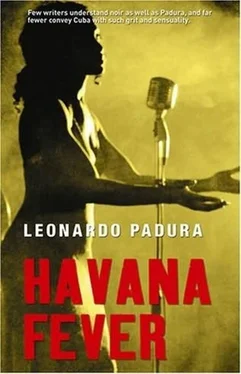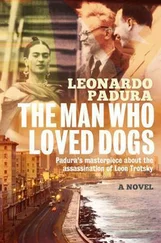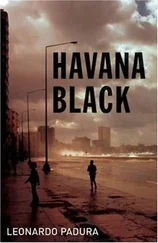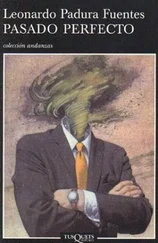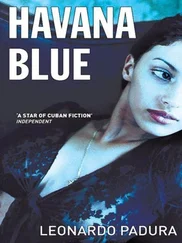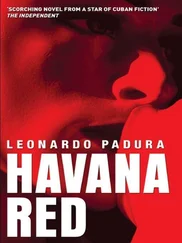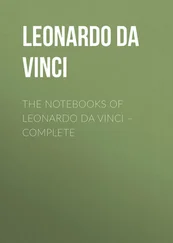Leonardo Padura - Havana Fever
Здесь есть возможность читать онлайн «Leonardo Padura - Havana Fever» весь текст электронной книги совершенно бесплатно (целиком полную версию без сокращений). В некоторых случаях можно слушать аудио, скачать через торрент в формате fb2 и присутствует краткое содержание. Жанр: Триллер, на английском языке. Описание произведения, (предисловие) а так же отзывы посетителей доступны на портале библиотеки ЛибКат.
- Название:Havana Fever
- Автор:
- Жанр:
- Год:неизвестен
- ISBN:нет данных
- Рейтинг книги:3 / 5. Голосов: 1
-
Избранное:Добавить в избранное
- Отзывы:
-
Ваша оценка:
- 60
- 1
- 2
- 3
- 4
- 5
Havana Fever: краткое содержание, описание и аннотация
Предлагаем к чтению аннотацию, описание, краткое содержание или предисловие (зависит от того, что написал сам автор книги «Havana Fever»). Если вы не нашли необходимую информацию о книге — напишите в комментариях, мы постараемся отыскать её.
Havana Fever — читать онлайн бесплатно полную книгу (весь текст) целиком
Ниже представлен текст книги, разбитый по страницам. Система сохранения места последней прочитанной страницы, позволяет с удобством читать онлайн бесплатно книгу «Havana Fever», без необходимости каждый раз заново искать на чём Вы остановились. Поставьте закладку, и сможете в любой момент перейти на страницу, на которой закончили чтение.
Интервал:
Закладка:
“I don’t think so… Why?”
“What about you, Dionisio?”
Dionisio barely looked up from the money, but did interrupt his counting.
“Never heard of her,” he said, then resumed his tallying.
The Count briefly told them about the cutting he’d found, and then spoke to Amalia.
“Perhaps your mother might remember her?”
“I told you she’s lost it…”
“But old people sometimes remember things from the past. Might I at least ask her?”
“No… It would make no sense,” Amalia responded as if it upset her to admit as much, and added: “Excuse me, I must go to the bathroom.”
She walked off between the marble columns and Dionisio, his mind closed to everything but counting notes, concentrated even harder on his task.
“Why does that woman interest you so much, Conde?” enquired Yoyi, smiling ironically.
“I haven’t a clue…” the Count lied, unable to admit what he’d found out that morning, and added, “Which bookseller knows the most about old records?”
“Pancho Carmona. You remember, he used to sell records.”
“I need too see him today.”
“You know,” Pigeon shook his head, “you’re madder than an old coot, I swear, man.”
“All present and correct,” Dionisio piped up.
“We can take all the books, can’t we?” Conde asked, assuming his honest looks might have waned over the last twenty-four hours.
“Yes,” replied Dionisio, after hesitating for a moment. “That’s not a problem.”
“Let’s get on with it then. I’ll get some boxes. My car’s outside,” announced Yoyi as he left.
Amalia emerged from the inner recesses of the house and sat next to her happy brother.
“So…” began Dionisio. “You’ll bring the rest of the money, won’t you?”
“Of course,” the Count reassured him. “Don’t worry. We’ve got to select more books… By the way, Dionisio, and do excuse my nosiness: why did you leave that corporation you worked for after you were demobbed from the army?”
Surprised by the question, Dionisio looked at the Count and then at his sister, who’d tipped the bookseller to that particular story.
“Because I saw things I didn’t like. I’m a decent chap. A revolutionary too, and don’t you forget it.”
The early morning and late evenings were the most fruitful hours for the sellers of old books who’d set up shop in the plaza de Armas, in the shade of weeping figs, the statue of the Father of the Fatherland, and austere palaces that were once the seat of a colonial power that believed the island was one of the most precious jewels in its imperial crown. The tourist hordes, either eager or bored by their compulsory immersion in a bath of pre-packed history, usually began or ended their itineraries in the old city in the vicinity of what was once its central square. Although the booksellers always welcomed them as potential, if overly wary customers, experience had shown they could get them to pocket the odd book only with great difficulty and after much persuasive spiel, and then it was usually one that was generally of little historical or bibliographical value. That throng of civil servants, small businessmen, hard-saving pensioners, old militants shorn of their militancy, but determined to see with their own eyes this last outpost of the most real socialism, together with a motley band of night-owls, talked into Cuba, the low cost paradise, by scheming travel agents, and who tended to be addicted to other more primitive passions, that were sensual, climatic, even ideological but never book-loving.
In fact, the sample of books on display in the historic square represented only the more sightly leftovers from the real banquet. Valuable volumes, the ones that would unerringly find their way to auctions where they’d wear a three or four digit ticket, were banned from sale to the public and were never part of these modest offerings. Such delicacies were generally set aside for more or less well-established buyers: a few diplomatic bibliophiles; foreign correspondents and businessmen based in Cuba, with enough dollars to buy paper jewels; a small number of Cubans who’d got rich legally, semi-legally or entirely illegally, intent on investing in safe bets; and a few book lovers who were frequent visitors to the islands and had established preferences in matters of literature, cigars and women. However, the real recipients of the invisible bibliographical rarities were various professional dealers in valuable books, particularly Spaniards, Mexicans and a few Miami and New York based Cubans, who supplied auctions or owners of bookshops that were advertised on the internet. In the early nineties these specialists had detected the rich Havana vein, exposed in the harshest years of the Crisis, and came ready to purchase whatever their desperate Cuban colleagues might generously offer. Then, when they’d made their connections and plumbed the mine’s depths, they changed tactics and brought on each trip a list of exotic goodies already flagged by customers seeking a specific title by a well-known author, and in a particular edition. This underground trade was by far the most productive and most dangerous, and now the Cuban authorities had rumbled that some booksellers had conspired with library employees to take Cuban and universal treasures, bibliographical holdings, including manuscripts that could never be recovered, out of the country. It was almost impossible to eradicate this constant drain because on occasions the provider was a librarian on two hundred and fifty pesos a month who found it difficult to resist an offer of two hundred dollars – representing twenty months of his salary – for extracting a magazine or tome requested by a determined buyer. Such piracy on the sly had forced Cuban libraries to lock their most precious books in remote vaults, but nobody could put a stop to the leak from a tap beyond repair, thanks to which some found a temporary solution to material deprivation.
Pancho Carmona enjoyed a reputation as the provider of the bibliographical jewels most in demand. His business card pompously introduced him as a specialist in rare and valuable books, although his commercial tentacles reached into adjacent areas, including the plastic arts, furniture, Tiffany jewellery and the most eclectic of antiques. Three times a week Pancho provided a range of legal delights in the plaza de Armas, and on the other three days, in the reception room of his own home, on calle Amargura, he’d organize a kind of bookshop only open to trustworthy or highly recommended customers. One month he’d invite them to sit on Louis XVI furniture, another on Second Empire armchairs and the next on comfortable Liberty sofas, always in the shadow of classic Cuban painting or drawing, lit by restored art nouveau lamps and surrounded by Murano or Bohemian glassware, keen to voyage to foreign parts. All his trade colleagues knew that neither place exhibited his most sought-after books, although nobody knew for sure where Carmona, a man whose best contacts came straight to him, as soon they arrived from Madrid, Barcelona, Rome, Miami and New York, kept his secret hoard.
Pancho had lived for twenty-five years on his salary as an industrial designer and had begun to specialize in the book trade when it took off as a profitable line, and the sales of records, his business at the time, took a turn for the worse, coinciding with the start of a Crisis that soon resulted in a bountiful harvest as far as he was concerned. Unlike other booksellers, Carmona had had the foresight from the start to see that the real money would never be in the modest exercise of buying books for two pesos to sell them for ten. The real challenge, he believed, was to take a leap into the void of really serious investment. Consequently, soon after embarking on this trade, he risked taking out a loan, once he’d sold his all-Soviet television, refrigerator and air conditioning acquired thanks to his former status as a model worker, in order to assemble the necessary funds to purchase bibliographical rarities that had been hidden for years and were now being disinterred by desperate hunger. He paid good prices to dispel the doubts of skeletal owners and fend off rival competition. Within a few months Pancho had accumulated several dozen exquisite volumes, which he put on sale at fair but high prices and, endlessly patient, on the verge of starvation, he sat down and waited for the spark to ignite. Fate smiled on him on one day in 1994 when he was close to suicide: a buyer flew in from Madrid and handed over $12,000 for a small job-lot that included A General and Natural History of the Indies , by Fernández de Oviedo, published in Madrid in 1851; the Picturesque Island of Cuba , by Andueza, also from Madrid, but from 1841; the Political Essay on the Island of Cuba , by Baron Humboldt, in two 1826 Parisian tomes; the classic Types and Customs from the Island of Cuba , illustrated by Víctor Patricio de Landaluze, in its 1891 Havana edition; the extraordinary Cuban edition of The Comedies of Don Pedro Calderón de la Barca , published in Havana in 1839 and illustrated by Alejandro Moreau and Federico Mialhe; and the six beautiful, much sought after volumes of the History of Cuban Families , written by Francisco Javier de Santa Cruz y Mallén, the Count of Jaruco and Santa Cruz del Mopox, in the substantial 1940-43 edition.
Читать дальшеИнтервал:
Закладка:
Похожие книги на «Havana Fever»
Представляем Вашему вниманию похожие книги на «Havana Fever» списком для выбора. Мы отобрали схожую по названию и смыслу литературу в надежде предоставить читателям больше вариантов отыскать новые, интересные, ещё непрочитанные произведения.
Обсуждение, отзывы о книге «Havana Fever» и просто собственные мнения читателей. Оставьте ваши комментарии, напишите, что Вы думаете о произведении, его смысле или главных героях. Укажите что конкретно понравилось, а что нет, и почему Вы так считаете.
